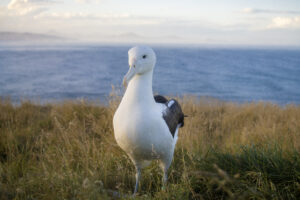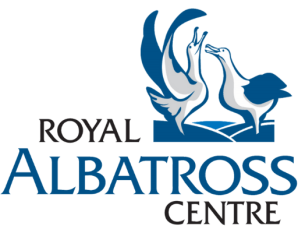NORTHERN ROYAL ALBATROSS / TOROA
(Diomedea sanfordi)
Albatross are the world’s largest seabirds. They usually breed on remote offshore islands and spend at least 85% of their lives at sea, well away from land and humans. Dunedin’s Taiaroa Head is the only mainland Royal Albatross breeding colony in the world. These birds are also a taonga species to Māori, highlighting cultural significance and importance.
Renowned ocean wanderers, they travel vast distances from their breeding grounds to feed on squid and octopus near the surface. With a massive three metre wingspan, Northern Royal Albatross easily fly an estimated 190,000 kilometres a year using a process called dynamic soaring. Essentially, they lock their wings out in place and will fly into the wind to gain height before turning and flying with the wind to gain speed. This creates an S-shape pattern across the ocean, allowing them to travel far without expending much energy.
The breeding birds arrive back to Taiaroa Head on the Otago Peninsula in September to reunite with their lifelong mates after spending a year alone at sea. They nest-build in October and, after numerous mating attempts, the single large white egg is laid during the first three weeks of November – they are slow breeding birds and lay only one egg per pair every two years.
The parents share incubation duty as it lasts a period of 80 days! The chicks hatch from late January to early February, and both parents take turns at guarding the chick for the first month to protect it from predators. After that the chicks enter post-guard and are left alone in the nest, with parents only returning with food every few days. It takes eight months for the little fluff balls to become not so little juveniles, and they will finally take their first ever flight in September! 12 months after their arrival at Taiaroa Head, and only after their chicks have departed, the parents finally leave the colony to spend a year at sea regaining body condition before returning to breed again the following season.



ROYAL CAM
Check out the live webcam of one of our Royal’s nests! Royal Cam runs 24 hours a day, tune in to watch what is happening on Taiaroa Head.

Follow our 2024/25 Royal Cam chick at the Signal Station Trig nest site!
2024/25 Royal Cam Chick Profile:
- Nest site name: Signal Station Trig
- Egg laid: 11 November 2024
- Chick hatched: 28 January 2025
- Mum: GLG (green lime green) currently 14 years old
- Dad: RLK (red lime black) currently 12 years old
Chicks Fledged:
- 2013/14 season: 26
- 2014/15 season: 24
- 2015/16 season: 23
- 2017/18 season: 13
- 2018/19 season: 28
- 2019/20 season: 24
- 2020/21 season: 30
- 2021/22 season: 25
- 2022/23 season: 33
- 2023/24 season: 33
- 2024/25 season: pending..
THREATS TO ALBATROSS
There are 22 species of albatross around the world, 18 of these are considered threatened on some level.
The New Zealand Conservation Status of the Northern Royal Albatross is Threatened – Nationally Vulnerable. They have only two nesting sites worldwide; 1% here at Pukekura / Taiaroa in Dunedin (estimated 70 breeding pairs), and the remaining 99% on the Chatham Islands (estimated 5,500 breeding pairs) where numbers are in decline.
The main threats: plastic pollution, long-line fisheries, and effects of climate change.
As albatross spend at least 85% of their lives at sea, there are many threats that can impact their chance of survival. Albatross are opportunistic scavengers, taking food such as squid, fish and octopus from the ocean’s surface. This style of hunting makes them vulnerable to ingesting plastic, as small fragments float conveniently along the surface of the water creating a similar appearance to their natural food.
Long-line fisheries are responsible for thousands of albatross deaths each year as a result of bycatch from easy-access baited hooks floating near the surface. The invention of the hook-pod has almost eliminated bycatch in long-line fisheries without affecting the catch-rate of the target species. The device works by covering the baited hook as it sinks below the ocean surface, only releasing using a pressure system once a predetermined depth is reached making it inaccessible to seabirds.
The work done by the Department of Conservation at Taiaroa Head, funded by you, is essential if we are to have any chance at protecting this endangered species. The Northern Royal Albatross found in Ōtepoti travel thousands of kilometres across the oceans each year, encountering a whole host of threats. By reducing our usage of single-use plastics and sourcing our fish sustainably, we can help protect what we have left.



HOW YOU CAN HELP
The Otago Peninsula Trust is a not-for-profit charitable conservation trust, relying on the help and support from you! There are a few ways in which you can help:
-
Visit Us – Book a guided tour to see the albatross! Click here for guided tour options.
-
Get Involved – Become a member today! Click here for more info.
-
Donate – Donations are a fantastic way to ensure that the work done to protect our wildlife can continue. Go to our Givealittle Fundraising page.
